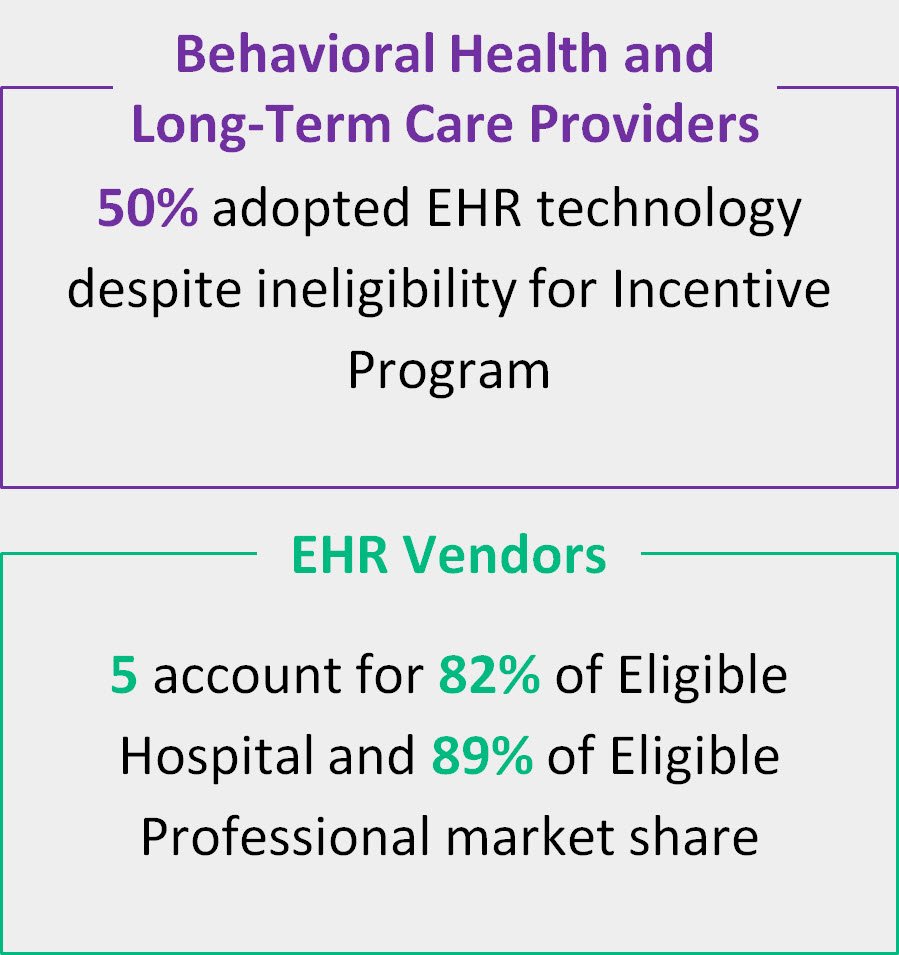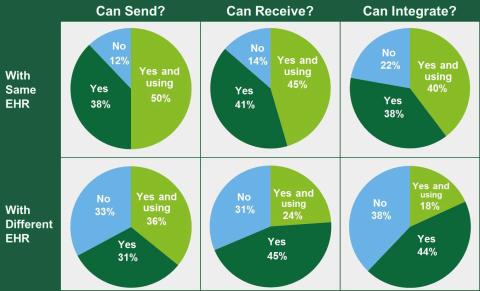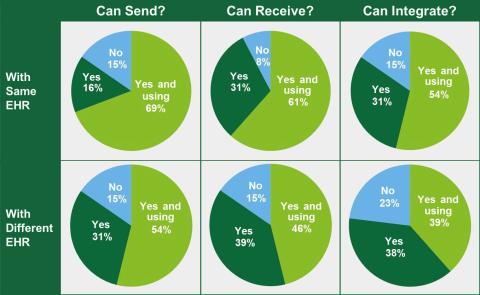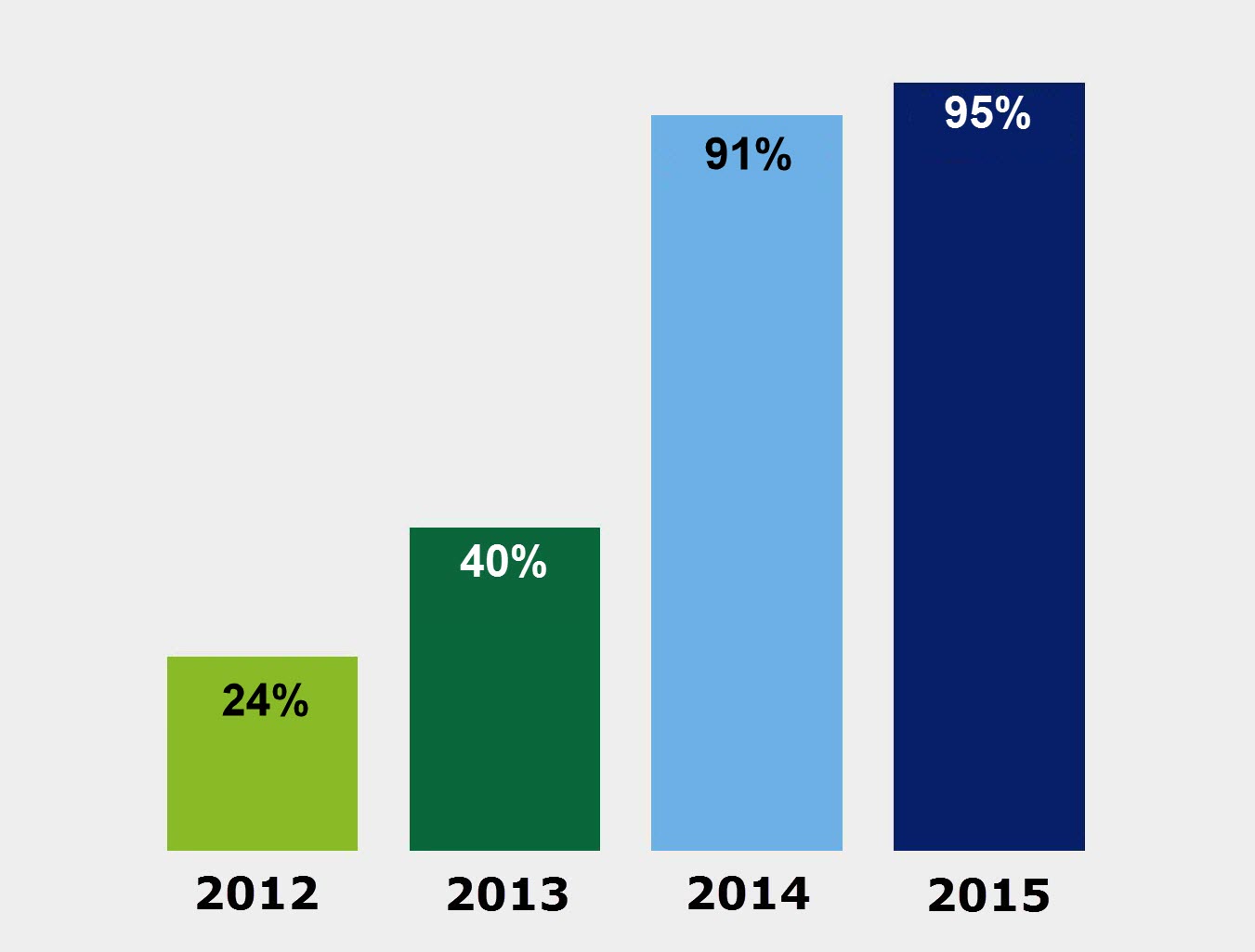Wisconsin Health IT Landscape
This page reports on Wisconsin’s health information technology (IT) adoption rates and maturity—the extent to which health IT is actively being used and integrated into the workflow of providers and to share data across organizations.
The content areas below examine health IT uses in Wisconsin through May 2017:
- Electronic health record (EHR) adoption and use
- Health information exchange (HIE)
- Health IT initiatives, such as:
- Electronic patient engagement
- Prescription Drug Monitoring Program
- Telehealth
- Electronic prescribing
A Quick Insight on EHR Adoption
According to the Office of the National Coordinator for Health IT (ONC), Wisconsin surpasses the national averages for both physicians and hospitals in adopting EHR technology.
- Ninety-seven percent of non-federal acute care hospitals have adopted a certified EHR.
- Ninety-three percent of all physicians have adopted an EHR, with 83 percent adopting a certified EHR.
For more insights, read our report: Health IT Landscape Assessment (PDF).
Three Insights on Meaningful Use in Wisconsin
Our latest market research shows that Wisconsin’s eligible providers (the majority of which are physicians) have a high EHR adoption rate and are demonstrating the use of EHR technology in a meaningful way.
Behavioral health and long-term care providers, two types of non-acute care providers not eligible for Meaningful Use incentives, have lower health IT adoption rates (responses varied among organization types). These providers most often reported EHRs benefited patient safety and noted that initial cost, staff education and training, and limited technical resources were their main challenges.
The market is dominated by a select group of EHR vendors, representing an opportunity for the state’s providers and hospitals to implement interoperable solutions capable of facilitating electronic health information exchange.
For more insights read our report: Health IT Landscape Assessment (PDF).
We recently surveyed Wisconsin hospitals and professionals about their EHR technology’s capability to send, receive, and use or integrate priority data domains electronically.
To summarize survey results:
- HIE capabilities are fairly strong. The vast majority of surveyed providers have EHRs with the capability to send, receive, and integrate data. When exchanging data across the same EHR technology, providers report between 80 and 90% capability in sending, receiving, or integrating data with other providers.
- Its easier to send than to receive or integrate: Providers are using EHRs to send data at a higher rate than receiving or integrating data. (Evident by the percent of "Yes and using” responses decreasing from left to right.)
- Integrating data from a different EHR is difficult. When exchanging data across different EHR technologies, use and capability (to send, receive, or integrate) decrease by a discernable amount—especially among health care professionals.
Professional HIE Capabilities
Hospital HIE Capabilities
Overall, this demonstrates that HIE capabilities are well developed, but the actual use of the technology to exchange data has room to grow. HIE capability will only improve as the industry increases its capability to exchange standardized transactions and additional organizations participate.
HIE Organizations Increase Capability and Use. Interestingly, survey data also shows that both HIE capability and use increased when exchanging via HIE organization networks or health information service providers. Currently, over 50 percent of the Wisconsin HIE organization market share is held by the state-designated HIE organization, the Wisconsin Statewide Health Information Network, followed by the eHealth Exchange, and then vendors such as SureScripts, Epic, and MaxMD. Health care entities are engaging with HIE organizations, yet a critical mass may not have been reached such that participation is seen as a benefit for all organizations.
Source: DHS, Health IT Landscape Assessment (PDF), May 2017
According to ONC data, digitizing the U.S. health system has empowered individuals to be more in control of decisions regarding their health and well-being and ready to act on providers’ recommendations.
- Individuals have access but are not viewing. Most hospitals and practices are providing electronic access to health information, but only about half of individuals viewed the record in the past year.
- Online access has value when used. The majority of people value online access to their health records, and 8 in 10 individuals who accessed their medical record online considered the information useful.
- Patient portals have varied uses. Most commonly, individuals reported they used their online access to health information to monitor their health by checking on medications and test results or downloading and sharing health information with family or providers.
- Getting online has positive effects. Individuals with electronic access to their health information attest to an increased ability to monitor chronic conditions, better adhere to treatment plans, find and fix errors in their records, and directly contribute their information to research.
Source: ONC, Data Brief 30 (PDF), October 2015
Patient Electronic Access to Health Information (2012-2015)
For more information about the value of consumer access and use of online health records, read this ONC infographic (PDF).
Wisconsin health care entities are interested in and using different tools to inform and engage with patients. All surveyed participants both offer and encourage use of online portals, which is bolstered by the Meaningful Use of certified EHRs.
Wisconsin providers in the EHR Incentive Program exceed or are on par with the national average for providing electronic capabilities to patients reporting when compared to the national percentage of hospitals and physicians (as calculated by ONC). However, this ability remains in the early stages of widespread availability and patient use. Less than half of patients used the ability to view, download, or transmit their medical records to a third party through December 2016.
Sources: DHS, Health IT Landscape Assessment (PDF), May 2017; ONC, Health IT Data Summaries: Patient Engagement
Overall, survey respondent familiarity with the PDMP was varied, with close to half of surveyed Wisconsin Medicaid hospitals, providers, and pharmacies using the Wisconsin PDMP with at least “often” frequency. Note: The survey was prior to the launch of the new ePDMP and relevant legislation.
While health care entities are familiar with and increasing their use of the PDMP, there is room to grow in integrating organizational technologies with the PDMP. Only 25 percent of pharmacies and 30 percent of hospitals and providers reported having some level of integration between PDMP data and their primary care, dispensing, and clinical workflows, but not their EHRs.
Source: DHS, Health IT Landscape Assessment (PDF), May 2017
Currently, Wisconsin Medicaid survey results indicate providers' use of telehealth services is average. This includes about 50 percent of hospitals, 20 percent of providers, and only 7 percent of pharmacies. The vast majority of telehealth services are provided synchronously (live video), followed by asynchronously (store and forward), remote patient monitoring, and to a lesser extent, mobile health.
While current Wisconsin Medicaid telehealth policy (ForwardHealth Topic 510) permits reimbursement for select synchronous telehealth services, Wisconsin Medicaid HMOs can allow coverage above ForwardHealth policy, and the majority of them do. There is considerable inclination among surveyed partners to expand the use of these services, including expanding allowable telehealth reimbursement sites and supporting behavioral health care services.
Source: DHS, Health IT Landscape Assessment (PDF), May 2017
While there is variation in electronic prescribing (e-prescribing) capabilities and use, the majority of Wisconsin Medicaid hospitals, providers, and pharmacies have the technology to support e-prescribing. However, report results suggest some difficulty in interacting electronically across organizations, or perhaps organizational policies limiting this capability.
One specific area of interest involves the activities surrounding controlled substances, including opioids. Just fewer than 50 percent of surveyed providers are e-prescribing controlled substances, although there is a marked difference between capability and interest. Almost all pharmacies reported receiving e-prescriptions, with 62 percent e-prescribing all or most controlled substances, including controlled substance schedule II or II-IV.
Source: DHS, Health IT Landscape Assessment (PDF), May 2017
Have a question? Send us an email at eHealth@wi.gov.






